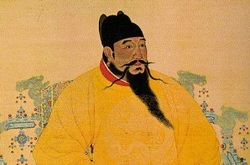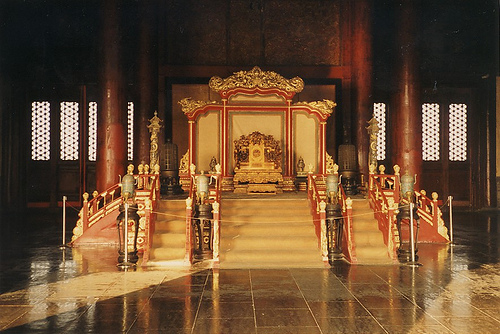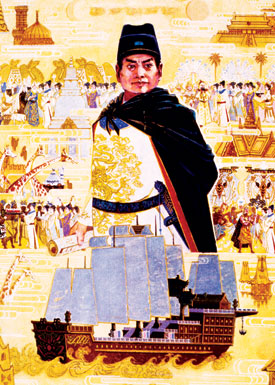The Continuation of Ming Dynasty - Yongle, Zheng He, Foreign Contact and The Forbidden City

Zhu Di - Yongle Emperor
The 2nd emperor of China named “Zhu Yunwen” or “Jianwen Emperor” was the grandson of Hongwu Emperor. He became Emperor because his father passed away and Hongwu decided to pick him out of the other 3 sons. Jianwen Emperor was thought to be threatening to the other warlords that ruled parts of China under him. His uncle named “Zhu Di” who had much of the emperor’s troops planned out a surprise assault into the capital Nanjing that eventually spreads out most of China and lasted for 3 years. Jianwen Emperor supposedly died in a fire but records also say he escaped and became a monk afterwards.
Zhu Di declared himself “Yongle Emperor”, burned parts of Nanjing, made it a secondary capital and moved the real capital to Beijing. He ordered the people to build him a huge palace that he could live in and it became a way to show how powerful he was. It was only a place for some government officials and all the imperial families. The Hall of Supreme Harmony was where political matters were discussed with the Emperor and the high ranking government officials.
During Yongle’s rule, an explorer called “Zheng He” was assigned to explore other foreign countries, increase trade possibilities and increase prominence in the known world. Zheng He was chosen as the admiral by Zhu Di, and another admiral called “Wang Jinghong” right under his command. Zheng He was chosen because he was very close with Zhu Di and he knew that Zheng He had the superior abilities to undertake matters like this. Zheng He became one of Zhu Di’s most trusted advisors and Zheng He because the maritime commander of China’s fleets and commerce.
Zheng He went on 7 expeditions to many nations and empires in Asia, Middle East and Africa. More than 300 fleets were involved, around 40 to 63 each time and around 27,000 to 28,000 crewmen for each voyage. Locations like Vietnam, the Philippines, Indonesia, Malaysia, South India, South Africa, East Coast of Africa and Mecca. Even though few foreign technologies have been already used in China, many of the fascinating inventions and technologies were actually brought to China from Zheng He’s voyages. He traded with the foreigners and gave them silk, porcelain, gold, silver, jewelry and other Chinese delicacies. What Zheng He got back were many different types of animals that China never knew about, including zebras, camels, ostriches and a giraffe from Swahili. He also established important trade routes to the places he visited and carefully planned them out so both side was able to receive goods and become good trading allies. After 20 years of voyage, his longtime friend, Yongle Emperor passed away, and the successor “Hongxi Emperor” decided to end the voyage because he thought it was wasting effort and money. However, he passed away and the following Emperor, “Xuande Emperor” allowed Zheng He to continue before he died during his 7th voyage. He had a grand funeral in China but his body was lost at sea.
However, that was not the only foreign contact that China had. Ming fought against the Mongols throughout the whole timeframe of Ming Dynasty and one of the Emperors, Zhengtong Emperor was captured for a year before he was sent back. Another occasion would be during late 16th and beginning of 17th century, where Wanli Emperor, the longest ruling Emperor of Ming helped out Korea against Japan. The Japanese wanted to conquer China but that ruined Korea because the Chinese and Japan fought on their soil instead of China’s of Japan’s. And soon after that, the Manchus began to invade China and eventually conquered China. Last but not least, the first Jesuit missionaries from Italy called “Matteo Ricci” arrived in China and he was able to bring much of the text from China back to Europe translated. He was also able to correctly translate the Chinese name of Confucius from Kong Fuzi so people in Europe could know about him. Finally, he created a version of the World Map upon a request of Wanli Emperor.
The irresponsibility of some of the Emperors, the total control of eunuchs and the corruption of government officials were the main reasons why Ming Dynasty became extremely vulnerable even on its own. However, since Ming Dynasty depended on silver as its main currency because of the overuse of paper, people began to riot and rebel against the Government when it starts to run out. At the same time, the Mongol Tribes in Manchuria has been invading Ming for decades. Without much supply for China’s huge army and the lack of many reliable commanders, Ming China wasn’t able to last very long.
Zhu Di declared himself “Yongle Emperor”, burned parts of Nanjing, made it a secondary capital and moved the real capital to Beijing. He ordered the people to build him a huge palace that he could live in and it became a way to show how powerful he was. It was only a place for some government officials and all the imperial families. The Hall of Supreme Harmony was where political matters were discussed with the Emperor and the high ranking government officials.
During Yongle’s rule, an explorer called “Zheng He” was assigned to explore other foreign countries, increase trade possibilities and increase prominence in the known world. Zheng He was chosen as the admiral by Zhu Di, and another admiral called “Wang Jinghong” right under his command. Zheng He was chosen because he was very close with Zhu Di and he knew that Zheng He had the superior abilities to undertake matters like this. Zheng He became one of Zhu Di’s most trusted advisors and Zheng He because the maritime commander of China’s fleets and commerce.
Zheng He went on 7 expeditions to many nations and empires in Asia, Middle East and Africa. More than 300 fleets were involved, around 40 to 63 each time and around 27,000 to 28,000 crewmen for each voyage. Locations like Vietnam, the Philippines, Indonesia, Malaysia, South India, South Africa, East Coast of Africa and Mecca. Even though few foreign technologies have been already used in China, many of the fascinating inventions and technologies were actually brought to China from Zheng He’s voyages. He traded with the foreigners and gave them silk, porcelain, gold, silver, jewelry and other Chinese delicacies. What Zheng He got back were many different types of animals that China never knew about, including zebras, camels, ostriches and a giraffe from Swahili. He also established important trade routes to the places he visited and carefully planned them out so both side was able to receive goods and become good trading allies. After 20 years of voyage, his longtime friend, Yongle Emperor passed away, and the successor “Hongxi Emperor” decided to end the voyage because he thought it was wasting effort and money. However, he passed away and the following Emperor, “Xuande Emperor” allowed Zheng He to continue before he died during his 7th voyage. He had a grand funeral in China but his body was lost at sea.
However, that was not the only foreign contact that China had. Ming fought against the Mongols throughout the whole timeframe of Ming Dynasty and one of the Emperors, Zhengtong Emperor was captured for a year before he was sent back. Another occasion would be during late 16th and beginning of 17th century, where Wanli Emperor, the longest ruling Emperor of Ming helped out Korea against Japan. The Japanese wanted to conquer China but that ruined Korea because the Chinese and Japan fought on their soil instead of China’s of Japan’s. And soon after that, the Manchus began to invade China and eventually conquered China. Last but not least, the first Jesuit missionaries from Italy called “Matteo Ricci” arrived in China and he was able to bring much of the text from China back to Europe translated. He was also able to correctly translate the Chinese name of Confucius from Kong Fuzi so people in Europe could know about him. Finally, he created a version of the World Map upon a request of Wanli Emperor.
The irresponsibility of some of the Emperors, the total control of eunuchs and the corruption of government officials were the main reasons why Ming Dynasty became extremely vulnerable even on its own. However, since Ming Dynasty depended on silver as its main currency because of the overuse of paper, people began to riot and rebel against the Government when it starts to run out. At the same time, the Mongol Tribes in Manchuria has been invading Ming for decades. Without much supply for China’s huge army and the lack of many reliable commanders, Ming China wasn’t able to last very long.


